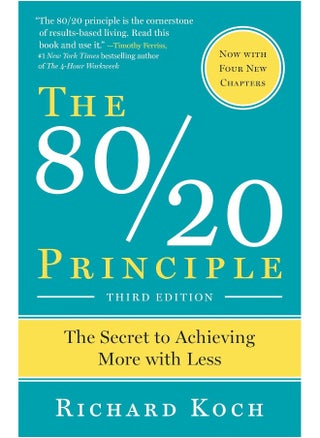| About the Author | Richard Koch is the bestselling author of The 80/20 Individual. An extraordinarily successful entrepreneur, his ventures have included consulting for hotels, restaurants, personal organizers, and the distilling industry. A former consultant with The Boston Consulting Group and former partner of Bain and Company, he currently lives in London, England. Excerpt. © Reprinted by permission. All rights reserved. Introduction: Welcome to the 80/20 PrincipleFor a very long time, the Pareto law [the 80/20 Principle] has lumbered the economic scene like an erratic block on the landscape; an empirical law which nobody can explain.--Josef SteindlThe 80/20 Principle can and should be used by every intelligent person in their daily life, by every organization, and by every social grouping and form of society. It can help individuals and groups achieve much more, with much less effort. The 80/20 Principle can raise personal effectiveness and happiness. It can multiply the profitability of corporations and the effectiveness of any organization. It even holds the key to raising the quality and quantity of public services while cutting their cost. This book, the first ever on the 80/20 Principle, is written from a burning conviction, validated in personal and business experience, that this principle is one of the best ways of dealing with and transcending the pressures of modern life.What is the 80/20 Principle?The 80/20 Principle asserts that a minority of causes, inputs, or effort usually lead to a majority of the results, outputs, or rewards. Taken literally, this means that, for example, 80 percent of what you achieve in your job comes from 20 percent of the time spent. Thus for all practical purposes, four-fifths of the effort--a dominant part of it--is largely irrelevant. This is contrary to what people normally expect.So the 80/20 Principle states that there is an inbuilt imbalance between causes and results, inputs and outputs, and effort and reward. A good benchmark for this imbalance is provided by the 80/20 relationship: a typical pattern will show that 80 percent of outputs result from 20 percent of inputs; that 80 percent of consequences flow from 20 percent of causes; or that 80 percent of results come from 20 percent of effort.In business, many examples of the 80/20 Principle have been validated. Twenty percent of products usually account for about 80 percent of dollar sales value; so do 20 percent of customers. Twenty percent of products or customers usually also account for about 80 percent of an organization's profits.In society, 20 percent of criminals account for 80 percent of the value of all crime. Twenty percent of motorists cause 80 percent of accidents. Twenty percent of those who marry comprise 80 percent of the divorce statistics (those who consistently remarry and redivorce distort the statistics and give a lopsidedly pessimistic impression of the extent of marital fidelity). Twenty percent of children attain 80 percent of educational qualifications available.In the home, 20 percent of your carpets are likely to get 80 percent of the wear. Twenty percent of your clothes will be worn 80 percent of the time. And if you have an intruder alarm, 80 percent of the false alarms will be set off by 20 percent of the possible causes.The internal combustion engine is a great tribute to the 80/20 Principle. Eighty percent of the energy is wasted in combustion and only 20 percent gets to the wheels; this 20 percent of the input generates 100 percent of the output!Pareto's discovery: systematic and predictable lack of balanceThe pattern underlying the 80/20 Principle was discovered in 1897, about 100 years ago, by Italian economist Vilfredo Pareto (1848-1923). His discovery has since been called many names, including the Pareto Principle, the Pareto Law, the 80/20 Rule, the Principle of Least Effort, and the Principle of Imbalance; throughout this book we will call it the 80/20 Principle. |
Free & Easy Returns
Best Deals





